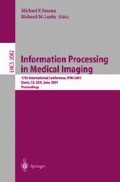Abstract
Skeleton is a frequently applied shape feature to represent the general form of an object. Thinning is an iterative object reduction technique for producing a reasonable approximation to the skeleton in a topology preserving way. This paper describes a sequential 3D thinning algorithm for extracting medial lines of objects in (26, 6) pictures. Our algorithm has been successfully applied in medical image analysis. Three of the emerged applications (analysing airways, blood vessels, and colons) are also presented.
Acknowledgment
This work was supported by the CEEPUS A-34 and FKFP 0908/1997 Grants.
Access this chapter
Tax calculation will be finalised at checkout
Purchases are for personal use only
Preview
Unable to display preview. Download preview PDF.
References
Blum, H.: A transformation for extracting new descriptors of shape. Models for the Perception of Speech and Visual Form, MIT Press, (1967) 362–380
Kong, T.Y., Rosenfeld, A.: Digital topology: Introduction and survey. Computer Vision, Graphics, and Image Processing 48 (1989) 357–393
Lee, T., Kashyap, R.L., Chu, C.: Building skeleton models via 3-D medial surface/axis thinning algorithms. CVGIP: Graphical Models and Image Processing 56 (1994) 462–478
Malandain, G., Bertrand, G.: Fast characterization of 3D simple points. In: Proc. 11th IEEE International Conference on Pattern Recognition (1992) 232–235
Palágyi, K., Kuba, A.: A parallel 3D 12-subiteration thinning algorithm. Graphical Models and Image Processing 61 (1999) 199–221
Saha, P.K., Chaudhuri, B.B.: Detection of 3-D simple points for topology preserving transformations with application to thinning. IEEE Transactions on Pattern Analysis and Machine Intelligence 16 (1994) 1028–1032
Saito, T., Toriwaki, J.: A sequential thinning algorithm for three dimensional digital pictures using the Euclidean distance transformation. In: Proc. 9th Scandinavian Conf. on Image Analysis, SCIA’95 (1995) 507–516
Author information
Authors and Affiliations
Editor information
Editors and Affiliations
Rights and permissions
Copyright information
© 2001 Springer-Verlag Berlin Heidelberg
About this paper
Cite this paper
Palágyi, K. et al. (2001). A Sequential 3D Thinning Algorithm and Its Medical Applications. In: Insana, M.F., Leahy, R.M. (eds) Information Processing in Medical Imaging. IPMI 2001. Lecture Notes in Computer Science, vol 2082. Springer, Berlin, Heidelberg. https://doi.org/10.1007/3-540-45729-1_42
Download citation
DOI: https://doi.org/10.1007/3-540-45729-1_42
Published:
Publisher Name: Springer, Berlin, Heidelberg
Print ISBN: 978-3-540-42245-7
Online ISBN: 978-3-540-45729-9
eBook Packages: Springer Book Archive

